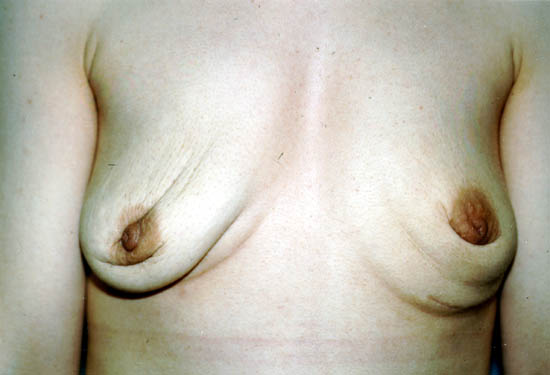Breast Implant Complications
The FDA has produced this brochure to highlight the more common problems that occur in the breast or chest area (local complications), when you choose to have silicone gel-filled or saline-filled breast implants.
For more detailed information and descriptions of diseases that women believe to be related to breast implants, read the FDA Breast Implant Consumer Handbook at
http://www.fda.gov/cdrh/breastimplants/.
[ad#inline-products-ad]
Potential local complications are shown alphabetically below. You may need non-surgical treatments or reoperations (including removal of your implant) to treat any of these.
- Asymmetry

- Breast pain
- Breast tissue atrophy
- Calcification/calcium deposits
- Capsular contracture
- Chest wall deformity
- Delayed wound healing
- Extrusion
- Galactorrhea
- Granuloma
- Hematoma
- Iatrogenic injury/damage
- Infection, including Toxic Shock Syndrome
- Inflammation/irritation
- Malposition/displacement
- Necrosis
- Nipple/breast changes
- Palpability/visibility
- Ptosis
- Redness/bruising
- Rupture/deflation
- Scarring
- Seroma
- Unsatisfactory style/size
- Wrinkling/rippling
Capsular contracture and rupture/deflation are the most common local complications that occur with both silicone gel-filled and saline-filled breast implants.
Capsular Contracture
Capsular contracture occurs when the scar tissue or capsule that normally forms around the implant tightens and squeezes the implant. It can happen to one or both of the implants. There are four grades of capsular contracture known as Baker grades.
The Baker grading is as follows
[ad#inline amazon ebay]Grade I
– breast is normally soft and looks natural
Grade II
– breast is a little firm but looks normal
Grade III
– breast is firm and looks abnormal
Grade IV
– breast is hard, painful, and looks abnormal
Capsular contracture may require reoperation, usually for Grades III and IV, and it may occur again.
Photograph 1 shows Grade IV capsular contracture in the right breast of a 29 year old woman seven years after sub-glandular placement of silicone gel-filled breast Implants.

Rupture/Deflation
Breast implants do not last a lifetime. Some breast implants may rupture/deflate in the first few months after surgery and some after several years. Others may take 10 or more years to rupture/deflate.
The reasons for rupture are not well understood and are currently being studied. Some possible causes of rupture/deflation include:
When silicone gel-filled implants rupture, some women may notice decreased breast size, hard knots, uneven appearance of the breasts, pain or tenderness, tingling, swelling, numbness, burning, or changes in sensation. Other women may unknowingly experience a rupture without any symptoms (silent rupture).
Magnetic resonance imaging (MRI) with equipment specifically designed for imaging the breast may be used for evaluating patients with suspected rupture or leakage of their silicone gel-filled implant. Silicone gel may escape from the scar tissue capsule around the implant migrate away from the breast cause lumps, called granulomas, to form in the breast, chest wall, armpit, arm, or abdomen.
Plastic surgeons usually recommend removal of the implant if it has ruptured, even if the silicone is still enclosed within the scar tissue capsule, because the silicone gel may eventually leak into surrounding tissues.
When saline-filled breast implants deflate, the saline solution leaks either through an unsealed or damaged valve or through a break in the implant shell. Implant deflation can be immediate or progress over a period of days, months, or years and is noticed by loss of size or shape of the implant. Additional surgery is needed to remove deflated implants. Photograph 2 below shows deflation of a 30-year-old woman’s left saline-filled breast implant. 
Reoperations
It is likely that you will need to have one or more reoperations over the course of your life because of local complications from breast implants. Reasons for reoperations could include any of the potential local complications above. Multiple reoperations to either improve the appearance of the breasts, to remove ruptured/deflated implants, or both may result in an unsatisfactory cosmetic outcome.
[ad#inline ad best type]
Removals
One type of reoperation is the removal of the implant(s), with or without replacement. Removal involves surgery. You are likely to have your implant removed at some time over the course of your life because of one or more local complications above. Many women decide to have the implants replaced, but some women do not. Women who do not have their implants replaced may have cosmetically undesirable dimpling, puckering, or sagging of the breast following removal of the implant.
 Photograph 3 shows the previously pictured 29 year old woman one year after removal of her silicone gel-filled breast implants without replacement.
Photograph 3 shows the previously pictured 29 year old woman one year after removal of her silicone gel-filled breast implants without replacement.
Key Points to Consider
Leave a Comment















Comments on Breast Implant Complications
I am doing research for my college paper, thanks for your excellent points, now I am acting on a sudden impulse.
– Kris
We are glad to hear about you using this topic for a paper. More people need to be aware of the dangers.
I like browsing your blog because there this information about breast enhancement that I have never heard before. I feel that I must at least say a thank you for your hard work.
– Henry